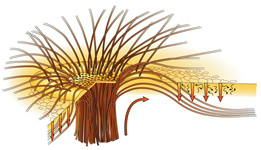
John H. Thomas
- Professor Emeritus of Mechanical and Aerospace Sciences
- Professor Emeritus of Astronomy, Department of Physics and Astronomy
PhD, Purdue University, 1966
344 Hopeman
(585) 275-4083
Fax: (585) 256-2509
thomas@me.rochester.edu
Research Overview
My research interests over most of my career have been in astrophysical and geophysical fluid dynamics and magnetohydrodynamics, especially as applied to the Sun. While most of my research has been theoretical in nature, I have also carried out telescopic observations of dynamical phenomena in sunspots and the solar atmosphere, at the National Solar Observatory in New Mexico. Some of my research involved collaborations with colleagues in Rochester’s Department of Physics and Astronomy and at the University of Cambridge in England, LAEFF in Madrid, the High Altitude Observatory in Boulder, and elsewhere. Recently my interests have turned to fluid dynamics of the brain’s glymphatic system. Specific topics of my research include:
Sunspot Structure and Dynamics
Theoretical models of intense magnetic flux tubes on the Sun. Calculations of siphon flows along magnetic flux tubes, including the effects of radiative transfer and variable ionization and the behavior of shock waves in supercritical flows. Theory and observation of the structure and dynamics of sunspots, especially the filamentary structure and Evershed flow in the penumbra. Numerical simulations of magnetic flux pumping in the photosphere around a sunspot.

Sunspot Seismology
Theory and observations of the interaction of a sunspot with the resonant acoustic modes of the Sun, as a means of probing the subsurface structure of a sunspot. The theoretical work involves the study of waves in a stratified, compressible, magnetized atmosphere.
Solar and Stellar Dynamos
Dynamo generation of magnetic fields in the Sun and other stars. Nonlinear and chaotic stellar dynamos.
Fluid Dynamics of the Brain’s Glymphatic System
The glymphatic system is a pathway for movement of cerebrospinal fluid through the brain that serves to remove metabolic waste products, including those proteins whose accumulation is associated with Alzheimer’s and other diseases. I am part of a team of researchers in Mechanical Engineering and the Medical School carrying out experimental and theoretical studies of fluid flow in this system, with support from NIH and the Army Research Office.
Representative Publications
- Sunspots: Theory and Observations, ed. J. H. Thomas & N. O. Weiss (Dordrecht: Kluwer), 428 pp., 1992.
- Localized Sources of Propagating Acoustic Waves in the Solar Photosphere (with T. M. Brown, T. J. Bogdan, and B.W. Lites), Astrophys. J. (Letters), Vol. 394, p. L65, 1992.
- The Absorption of p-Modes by Sunspots: Variations with Degree and Order (with T. J. Bogdan, T. M. Brown, and B. W. Lites), Astrophys. J., Vol. 406, p. 723, 1993.
- A Siphon-Flow Model of the Photospheric Evershed Flow in a Sunspot (with B. Montesinos), Astrophys. J., Vol. 407, p. 398, 1993.
- Dynamo Generation of Magnetic Fields in White Dwarfs (with J. A. Markiel and H. M Van Horn), Astrophys. J., Vol. 453, p. 403, 1995.
- The Vector Magnetic Field, Evershed Flow, and Intensity in a Sunspot (with D. C. H. Stanchfield and B. W. Lites), Astrophys. J., Vol. 477, p. 485, 1997.
- Simple Solar Dynamo Models with Variable Alpha and Omega Effects (with C. B. Roald), Mon. Not. Roy. Astron. Soc., Vol. 288, p. 551, 1997.
- The Evershed Effect in Sunspots as a Siphon Flow Along a Magnetic Flux Tube (with B. Montesinos), Nature, Vol. 390, p. 485, 1997.
- Velocity and Magnetic Field Fluctuations in the Photosphere of a Sunspot (with B. W. Lites, T. J. Bogdan, and P. Cally), Astrophys. J., Vol. 497, p. 464, 1998.
- Solar Interface Dynamo Models With a Realistic Rotation Profile (with J. A. Markiel), Astrophys. J., Vol. 523, p. 827, 1999.
- Fine-Scale Magnetic Effects on p-modes and Higher Frequency Acoustic Waves in a Solar Active Region (with D. C. H. Stanchfield, II), Astrophys. J., Vol. 537, p. 1086, 2000.
- Dynamos in Asymptotic-Giant-Branch Stars as the Origin of Magnetic Fields Shaping Planetary Nebulae (with E. G. Blackman, A. Frank, J. A. Markiel, and H. M. Van Horn), Nature, Vol. 409, p. 485, 2001.
- A New Look at the Relationship Among Activity, Dynamo Number, and Rossby Number in Late-Type Stars (with B. Montesinos, P. Ventura, and I. Mazzitelli), Mon. Not. Roy. Astron. Soc., Vol. 326, p. 877, 2001.
- [PDF] Downward Pumping of Magnetic Flux as the Cause of Filamentary Structures in Sunspot Penumbrae (with N. O. Weiss, S. M. Tobias, and N. H. Brummell) Nature, Vol. 420, p. 390, 2002.
- Fuel-Supply-Limited Stellar Relaxation Oscillations: Application to Multiple Rings Around Asymptotic Giant Branch Stars and Planetary Nebulae (with H. M. Van Horn, A. Frank, and E. G. Blackman), Astophys. J., Vol. 585, p. 983, 2003.
- [PDF] The Origin of Penumbral Structure in Sunspots: Downward Pumping of Magnetic Flux (with N. O. Weiss, N. H. Brummell, and S. M. Tobias), Astrophys. J., Vol. 600, p. 1073, 2004.
- [PDF] Fine Structure in Sunspots (with N. O. Weiss), Ann. Rev. Aston. Astrophys., Vol. 42, p. 517, 2004.
- [PDF] Flux Pumping and Magnetic Fields in the Outer Penumbra of a Sunspot. (with N.H. Brummell, S.M. Tobias, and N.O. Weiss), Astrophys. J., Vol. 686, p. 1454, 2008.
- Sunspots and Starspots (with N.O. Weiss), Cambridge University Press (Cambridge Astrophysics Series), 275 pp., 2008.
- [PDF] Theoretical Models of Sunspot Structure and Dynamics, in Magnetic Coupling Between the Interior and the Atmosphere of the Sun. ed. S.S. Hasan and R.J. Rutten, Springer-Verlag, p. 239, 2010.
- [PDF] Flow of cerebrospinal fluid is driven by arterial pulsations and is reduced in hypertension (with several co-authors), Nature Communications, 9:4878, 2018.
- [PDF] Hydraulic Resistance of Periarterial Spaces in the Brain (with J. Tithof, D. H.Kelley, H. Mestre, and M. Nedergaard), Fluids and Barriers of the CNS 16:19, 2019.
- [PDF] Fluid dynamics of cerebrospinal fluid flow in perivascular spaces (invited review).J. Roy. Soc. Interface, 16: 20190572, 2019
- [PDF] Surface periarterial spaces in the mouse brain are open, not porous (with F. Min Rivas, J. Liu, B. C. Martell, T. Du, H. Mestre, M. Nedergaard, M., J. Tithof, and D.H. Kelley). J. Roy Soc. Interface, 17: 20200593, 2020
- Theoretical analysis of wake/sleep changes in brain solute transport suggests a flow of interstitial fluid. Fluids and Barriers of the CNS, 19:30, 2022.
- Cerebrospinal fluid flow (with D. H.Kelley), Ann. Rev. Fluid Mech., 55, 237, 2023.
Research Interests
- Astrophysical fluid dynamics
- Magnetohydrodynamics of the Sun and other stars
- Fluid dynamics of the brain's waste-removal system
